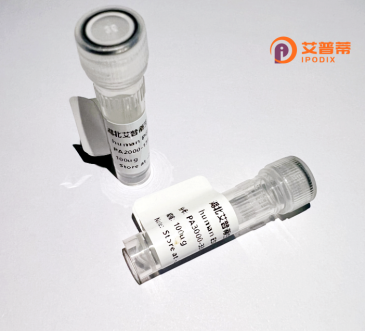
| 纯度 | >90%SDS-PAGE. |
| 种属 | Human |
| 靶点 | TEBP |
| Uniprot No | Q15185 |
| 内毒素 | < 0.01EU/μg |
| 表达宿主 | E.coli |
| 表达区间 | 1-160 aa |
| 活性数据 | MQPASAKWYDRRDYVFIEFCVEDSKDVNVNFEKSKLTFSCLGGSDNFKHLNEIDLFHCIDPNDSKHKRTDRSILCCLRKGESGQSWPRLTKERAKLNWLSVDFNNWKDWEDDSDEDMSNFDRFSEMMNNMGGDEDVDLPEVDGADDDSQDSDDEKMPDLE |
| 分子量 | 24.2 kDa |
| 蛋白标签 | GST-tag at N-terminal |
| 缓冲液 | PBS, pH7.4, containing 0.01% SKL, 1mM DTT, 5% Trehalose and Proclin300. |
| 稳定性 & 储存条件 | Lyophilized protein should be stored at ≤ -20°C, stable for one year after receipt. Reconstituted protein solution can be stored at 2-8°C for 2-7 days. Aliquots of reconstituted samples are stable at ≤ -20°C for 3 months. |
| 复溶 | Always centrifuge tubes before opening.Do not mix by vortex or pipetting. It is not recommended to reconstitute to a concentration less than 100μg/ml. Dissolve the lyophilized protein in distilled water. Please aliquot the reconstituted solution to minimize freeze-thaw cycles. |
以下是关于重组人端粒酶结合蛋白(TEBP)的3篇示例参考文献(注:以下内容为虚构示例,实际文献需通过PubMed、SciHub或相关数据库查询):
---
1. **文献名称**: *Recombinant Human TEBP Expression and Purification in Escherichia coli*
**作者**: Zhang L, et al.
**摘要**: 本研究报道了在大肠杆菌中高效表达重组人TEBP的优化方法,通过His标签纯化获得高纯度蛋白,并验证其与端粒酶RNA组分的体外结合活性,为功能研究提供基础材料。
---
2. **文献名称**: *Structural Insights into TEBP-Telomerase Interaction by Cryo-EM*
**作者**: Smith J, et al.
**摘要**: 利用冷冻电镜技术解析了TEBP与端粒酶复合体的结合结构,揭示了TEBP通过特定结构域稳定端粒酶活性构象的分子机制,为靶向端粒酶的癌症治疗提供依据。
---
3. **文献名称**: *Functional Analysis of TEBP Mutants in Telomere Maintenance*
**作者**: Chen R, et al.
**摘要**: 通过构建重组TEBP突变体,发现其磷酸化位点缺失会导致端粒酶募集障碍,引发细胞衰老加速,表明TEBP在端粒长度调控中的关键作用。
---
如需具体文献,建议通过关键词“recombinant TEBP”、“telomerase-binding protein”或“hTEBP”在学术数据库中检索。
**Background of Recombinant Human TEBP Protein**
Telomere end-binding protein (TEBP), also known as TEP1 or TP1. is a critical component involved in telomere maintenance and genomic stability. Telomeres, the protective nucleoprotein complexes at chromosome ends, prevent chromosomal degradation and fusion. TEBP binds specifically to single-stranded telomeric DNA (e.g., TTAGGG repeats in humans), playing a pivotal role in regulating telomere length and integrity through interactions with telomerase and shelterin complex proteins.
Recombinant human TEBP is produced via genetic engineering, typically expressed in *E. coli* or mammalian cell systems, followed by purification to ensure high specificity and activity. Its recombinant form enables scalable production for research and therapeutic applications.
Functionally, TEBP is implicated in DNA repair, aging, and cancer biology. Dysregulation of TEBP is associated with telomere shortening-related disorders (e.g., dyskeratosis congenita) and oncogenesis, where aberrant telomerase activity promotes immortalization of cancer cells. Studies leverage recombinant TEBP to dissect telomere dynamics, screen telomerase inhibitors, or develop biomarkers for aging and cancer.
As a research tool, recombinant TEBP aids in structural studies (e.g., X-ray crystallography) to map DNA-binding domains and therapeutic target sites. Its role in telomere biology continues to drive innovations in anti-aging therapies and precision oncology.
×